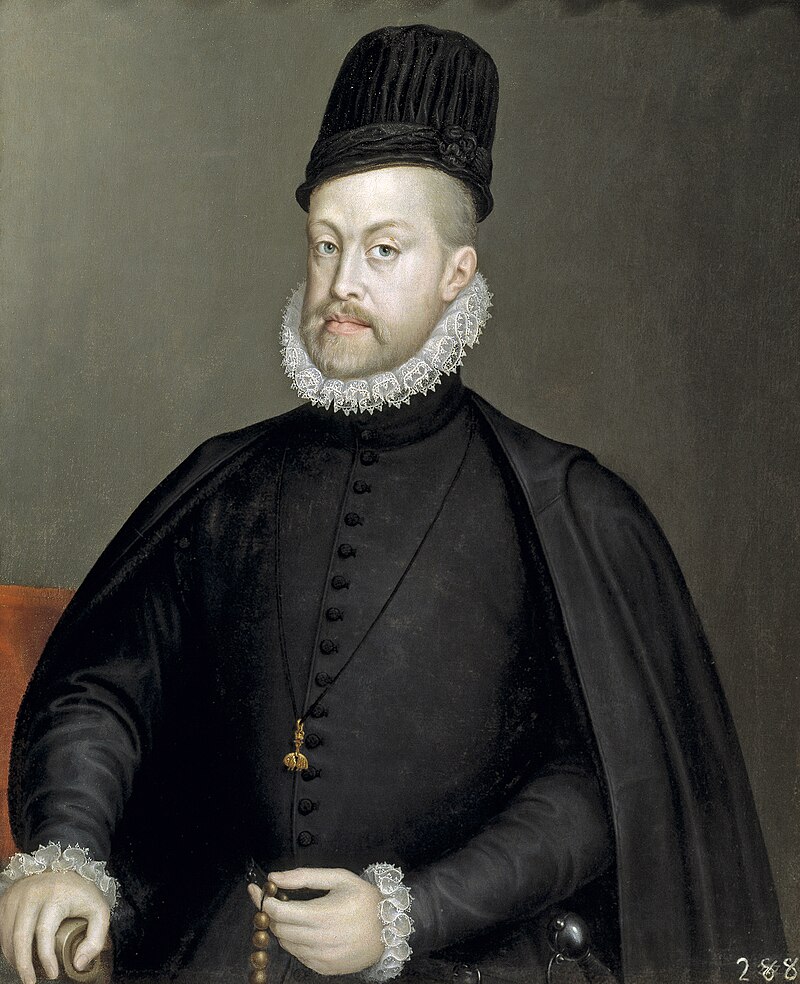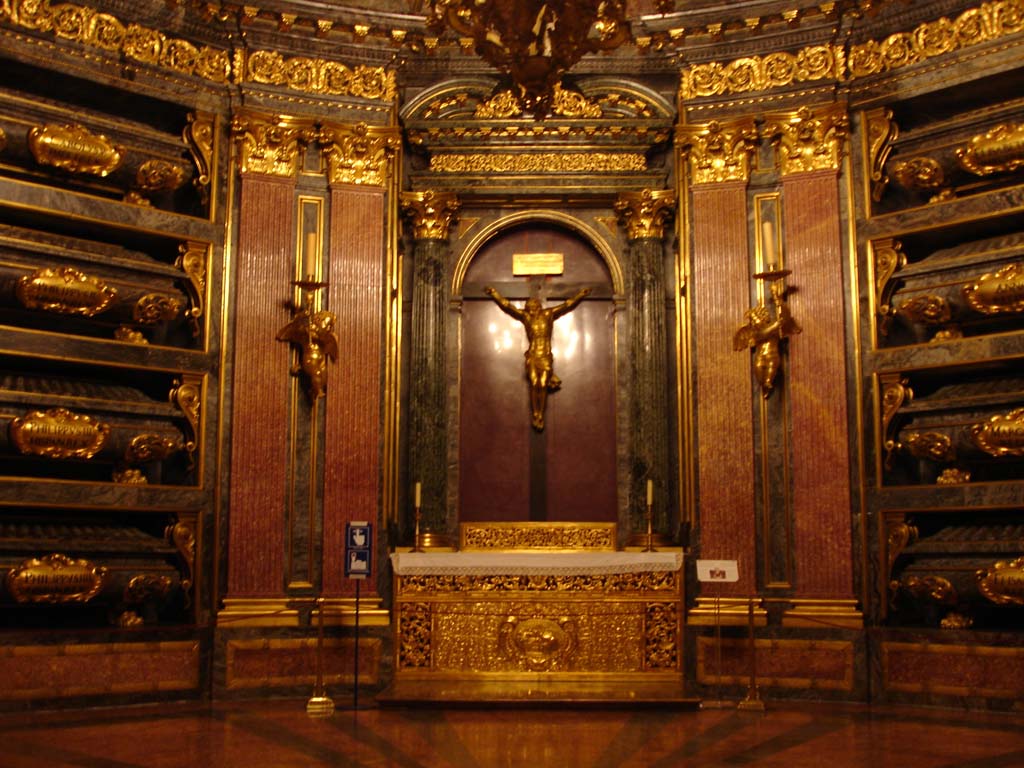by Susan Flantzer
© Unofficial Royalty 2022

Felipe III, King of Spain; Credit – Wikipedia
Besides being King of Spain, Felipe was also King of Portugal (1578 – 1621), King of Sardinia (1598 – 1621), King of Naples (1598 – 1621), King of Sicily (1598–1621), and Duke of Milan (1598–1621).
Felipe III, King of Spain was born on April 14, 1578, at the Royal Alcázar of Madrid in Madrid, Spain. Felipe was the fourth of the five children and the fourth of the four sons of Felipe II, King of Spain and his fourth wife and niece Anna of Austria. Felipe III’s paternal grandparents were Charles V, Holy Roman Emperor/Carlos I, King of Spain and Isabella of Portugal. His maternal grandparents were Maximilian II, Holy Roman Emperor, and Maria of Austria.


Felipe III’s parents: Felipe II, King of Spain and Anna of Austria; Credit – Wikipedia
The Spanish House of Habsburg was notorious for its inbreeding. The Habsburgs had built their empire by marriage and wanted to keep the land they amassed all in the family, so they began to intermarry more and more frequently among themselves. Of the eleven marriages of Spanish monarchs between 1450 and 1661, nearly all contained some element of consanguinity, marriages between very closely related people. Felipe III’s father Felipe II was the child of first cousins. Felipe III’s mother was also the child of first cousins and the niece of her husband. Felipe III married his first cousin once removed, who was also his second cousin. Felipe III’s son and successor Felipe IV married his niece. The Spanish House of Habsburg would end with the reign of Felipe IV’s physically and mentally disabled son Carlos II, King of Spain. While a person in the fifth generation normally has thirty-two ancestors, Carlos II had only ten ancestors in the fifth generation. Seven of his eight great-grandparents were descended from Juana I, Queen of Castile and León and her husband Philip of Habsburg, Duke of Burgundy. See the family tree of the ancestors of Felipe III and his wife at Wikipedia: Family Tree of Felipe III of Spain.
Felipe III had four siblings who all died in childhood:
- Ferdinand, Prince of Asturias (1571 – 1578), died in childhood of dysentery
- Infante Carlos Lorenzo (1573 – 1575), died in childhood
- Diego, Prince of Asturias (1575 – 1582), died in childhood of smallpox
- Infanta Maria (1580 – 1583), died in childhood

Felipe III’s half-brother Carlos, Prince of Asturias; Credit – Wikipedia
Felipe had one half-brother from his father’s first marriage to Maria Manuela of Portugal, who died ten years before Felipe’s birth:
- Carlos, Prince of Asturias (1545 – 1568), died unmarried, Carlos was mentally unstable and was imprisoned in his rooms by his father Felipe II in early 1568 after participating in a plot to murder Felipe II


Felipe III’s half sisters Isabella Clara Eugenia and Catalina Micaela; Credit – Wikipedia
Felipe had two half-sisters from his father’s third marriage to Elisabeth of Valois:
- Isabella Clara Eugenia of Austria, Infanta of Spain (1566 – 1633), married Albert VII, Archduke of Austria, no children
- Catalina Micaela of Austria, Infanta of Spain (1567 – 1597), married Carlo Emmanuel I, Duke of Savoy, had ten children
When Felipe III was two years old, his mother Anna died from influenza at the age of 30, on October 26, 1580, eight months after giving birth to her youngest child. Felipe II never remarried.
Felipe III’s elder half-brother Carlos, Prince of Asturias, who died ten years before Felipe III’s birth, had poor health, was deformed, and was mentally disabled. Many of his physical and mental disabilities may have stemmed from the inbreeding common in the House of Habsburg. However, his father Felipe II, unaware of the results that inbreeding could cause, believed that Carlos’ upbringing had been severely compromised, leading to his problems. Felipe II carefully appointed the people who would raise and educate Felipe III to provide him with a consistent, stable upbringing to ensure that he did not meet the same fate as Carlos. Restrictions were placed on Felipe III at an early age to shape his personality so that he would become a king who would be neither tyrannical nor under the strong influence of his courtiers. The goal of Felipe III’s upbringing seems to have been mostly successful. He was not particularly intelligent or academically gifted, but he was pleasant, pious, and had a respectful demeanor.
In 1578, King Sebastian of Portugal from the House of Aviz was killed in battle without any heirs, causing a succession crisis. He was succeeded by his elderly great-uncle Henrique, a Cardinal of the Roman Catholic Church, and had no descendants because he had taken a vow of chastity as a priest. When Cardinal-King Enrique died two years later, three grandchildren of Manuel I, King of Portugal (1469 – 1521) claimed the Portuguese throne. Ultimately, the grandchild who was successful in his claim was Felipe III’s father Felipe II, King of Spain. The Iberian Union was the union of the Kingdom of Spain and the Kingdom of Portugal that existed between 1580 and 1640, under the Spanish Habsburg kings Felipe II, Felipe III, and Felipe IV, who reigned in Portugal under the names Filipe I, Filipe II, and Filipe III.

Felipe II, King of Spain on his deathbed, blessing his son, the soon-to-be Felipe III, King of Spain in the presence of the Infanta Isabel Clara Eugenia by Francisco Jover Casanova; Credit – Wikipedia
In the 1590s, the health of Felipe II, King of Spain worsened. Gout was causing him severe pain, making him nearly immobile, and a special wheelchair was made for him. He also suffered from recurring episodes of malaria. During the last three months of his life, Felipe II was bedridden and in great agony. He died at the age of 71 on September 13, 1598, and his twenty-year-old son succeeded him as Felipe III, King of Spain. Besides being King of Spain, Felipe III was also King of Portugal, King of Sardinia, King of Naples, King of Sicily, and Duke of Milan.

Margaret of Austria, Queen of Spain; Credit – Wikipedia
On April 18, 1599, at Valencia Cathedral in Valencia, Spain, 21-year-old Felipe III married 14-year-old Archduchess Margaret of Austria, daughter of Karl II, Archduke of Inner Austria and his niece Maria Anna of Bavaria. Felipe and Margaret, both children of parents who were an uncle and his niece, were both first cousins once removed and second cousins, adding to more inbreeding.

Felipe III’s son and successor the future Felipe IV, King of Spain with his sister Anne, who married Louis XIV, King of France; Credit – Wikipedia
Felipe III and Margaret had eight children:
- Anne of Austria, Infanta of Spain (1601 – 1666), married Louis XIII, King of France, had two sons Louis XIV, King of France and Philippe I, Duke of Orléans
- Maria of Austria, Infanta of Spain (born and died 1603)
- Felipe IV, King of Spain (1605 – 1665), married (1) Elisabeth of France, had eight children including Maria Theresia of Austria, Infanta of Spain who married her first cousin Louis XIV, King of France (2) Marianna of Austria, his niece, had five children, including Carlos II, King of Spain
- Maria Anna of Austria, Infanta of Spain (1606 – 1646), married Ferdinand III, Holy Roman Emperor, had six children including Leopold I, Holy Roman Emperor and Marianna of Austria, who married her maternal uncle Felipe IV, King of Spain
- Carlos of Austria, Infante of Spain (1607 – 1632), unmarried
- Ferdinand of Austria, Cardinal-Infante of Spain (1609 – 1641), unmarried
- Margarita of Austria, Infanta of Spain (1610 – 1617), died in childhood
- Alonso of Austria, Infante of Spain (1611 – 1612), died in infancy
On October 3, 1611, at the Royal Site of San Lorenzo de El Escorial in El Escorial, Spain, Felipe III’s wife Margaret died at the age of twenty-six from childbirth complications eleven days after giving birth to her eighth child. Margaret was interred in the Pantheon of Kings at the Royal Basilica of San Lorenzo de El Escorial. Felipe never remarried.
Although a goal of Felipe III’s upbringing had been to prevent the strong influence of his courtiers, his reign was marred by his association with Francisco de Sandoval y Rojas, 1st Duke of Lerma. While in his teens, Felipe met Lerma, who was twenty-six years older and served as a gentleman of the bedchamber to Felipe II. Within hours of becoming King of Spain, Felipe III entrusted all authority to Lerma, who amassed unprecedented power and wealth. Felipe’s dependence on his corrupt chief minister, the Duke of Lerma, drew much criticism at the time and afterward. In 1618, Lerma was deposed by a palace intrigue.
Felipe III’s reign was marked by significant economic problems. In the 1590s, Spain was hit by famine due to a series of poor harvests. There was an outbreak of bubonic plague starting in 1599 and continuing for several years that killed more than 10% of the population. However, part of the Spanish Golden Age (1492 – 1659), a period of flourishing in the arts and literature, occurred during the reign of Felipe III. The Pax Hispanica was a period of twenty-three years from 1598 to 1621, when Spain disengaged from the European wars of religion, and peace treaties were signed with the Kingdom of France, the Kingdom of England, and the Dutch United Provinces.

The Pantheon of Kings at the Royal Basilica of San Lorenzo de El Escorial; Credit – Wikipedia
Felipe III, King of Spain, survived his wife by ten years, dying in Madrid, Spain on March 31, 1621, two weeks before his forty-third birthday, due to erysipelas, a bacterial skin infection. He was interred in the Pantheon of Kings at the Royal Basilica of San Lorenzo de El Escorial.

Tomb of Felipe III, King of Spain; Credit – www.findagrave.com
This article is the intellectual property of Unofficial Royalty and is NOT TO BE COPIED, EDITED, OR POSTED IN ANY FORM ON ANOTHER WEBSITE under any circumstances. It is permissible to use a link that directs to Unofficial Royalty.
Works Cited
- De.wikipedia.org. 2022. Philipp III. (Spanien) – Wikipedia. [online] Available at: <https://de.wikipedia.org/wiki/Philipp_III._(Spanien)> [Accessed 30 August 2022].
- Discover Magazine. 2019. Inbreeding and the Downfall of the Spanish Hapsburgs. [online] Available at: <https://www.discovermagazine.com/the-sciences/inbreeding-and-the-downfall-of-the-spanish-hapsburgs> [Accessed 30 August 2022].
- En.wikipedia.org. 2022. Philip III of Spain – Wikipedia. [online] Available at: <https://en.wikipedia.org/wiki/Philip_III_of_Spain> [Accessed 30 August 2022].
- Es.wikipedia.org. 2022. Felipe III de España – Wikipedia, la enciclopedia libre. [online] Available at: <https://es.wikipedia.org/wiki/Felipe_III_de_Espa%C3%B1a> [Accessed 30 August 2022].
- Flantzer, Susan, 2019. King Philip II of Spain. [online] Unofficial Royalty. Available at: <https://www.unofficialroyalty.com/king-philip-ii-of-spain/> [Accessed 30 August 2022].
- Wheatcroft, Andrew (1995). The Habsburgs. London: Viking.
